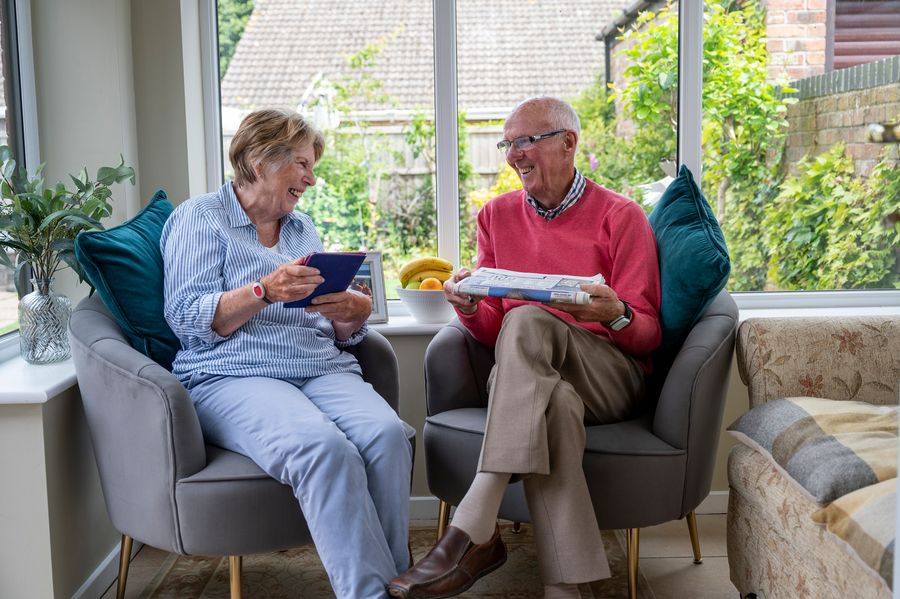EXCLUSIVE: How technology can enable older people to live safely and independently at home

In order to promote independence and empower people to engage with their health and wellbeing, collaboration and forward-thinking leadership is required to encourage the public to plan for the future and consider the benefits of technology enabled care services.
Gavin Bashar, UK & Ireland managing director at Tunstall Healthcare, discusses the future of retirement care and how technology can enable older people to live safely and independently at home for as long as possible after retirement.
Ageing in place
A crucial component of successful ageing is maintaining one’s independence and this can be achieved through ageing in place. This has been broadly defined as the ability to stay in one’s own home as a person ages. Older adults often express as a primary goal to age in place, and residential care settings are often not a place of choice but of necessity.
However, age-related chronic diseases can cause a decline in the capability of an older person’s ability to maintain their health and wellbeing at home, therefore threatening successful ageing in place. Adults on the brink of retirement and those who are beginning to see the effects of chronic diseases should be supported to be aware of the options available to them to remain at home for as long as possible.
Planning ahead can be hard for people who don’t yet need additional care and support at home as needs can change, however considering the types of help that are available and what might be required is a good starting point. This can include considering how potential support might differ for those living alone, and whether there are any adaptations that can be made in the home that will be useful in the future.

Challenges to ageing in place
While we know that many older adults want to stay in their own homes as they age, there are specific challenges which can lead to people having to move to a residential care setting, such as a care home or retirement village.
Common concerns of people planning to age at home include lack of mobility both in the home and in the community, finding and taking part in social activities, building and maintaining friendships, getting help during the day and more general safety concerns.
Between now and 2040 there will be an extra six million over 65s, and so it’s extremely important that we work together to mitigate these concerns and highlight the impact that technology can have on supporting and promoting independence and safety at home.
By understanding the nature of issues that older adults might encounter at home, we are better placed to co-design straight-forward and effective solutions.
The role of technology
There is clear evidence that older people have understood the benefits of staying healthy, well and independent for many years1. The Government is beginning to address this and look to understand what will achieve a healthier ageing population, most recently in the adult social care reform white paper People at the Heart of Care. However there is still a significant way to go, and engagement with people is crucial to gain further insight.
We must support people who are keen to stay at home for as long as possible and emphasise the benefits of technology. Integrating technology into people’s homes as they age to prepare for retirement care offers a significant number of benefits, including greater engagement with health and wellbeing, reducing and reversing frailty, and providing more effective and cost-efficient delivery of health and care.
Using technology to support people is low cost, meaning citizens can stay at home for longer with an increased quality of life. Likewise, relatively low-cost telecare systems can help to avoid hospital admission, delay and prevent the need for residential care, and reduce carer burnout.
These systems combine a range of unobtrusive alarms and sensors which detect events such as smoke, gas or a person falling, with a response from a 24-hour specialist monitoring centre where the operator will contact family members, response teams or the emergency services to provide help.
The huge range of technology available can support more person-centred and proactive care, and ensure that all care and support is tailored to each individual living at home. Care delivery can become more flexible and delivered where it’s needed most, and technology can provide peace of mind to older and vulnerable homeowners that their health and wellbeing is monitored.
Remote Patient Monitoring (RPM), for example, not only empowers people to understand and monitor their own health, but also supports clinicians and community providers in ensuring care is delivered to those who need it most. This keeps individuals active and independent for longer as they receive intelligent care, and can reduce the risk of hospitalisation.
The next steps
Increased integration and the use of technology enhances the care that people can receive and enables them to remain at home for longer. This can also increase the efficiency and capacity of services.
Other challenges remain, such as the UK’s move from analogue to digital communications network. This will require significant investment from the public sector at a time when budgets are already under extreme pressure, however, this brings a once in a generation opportunity to modernise, improve and shift thinking from a reactive, to a proactive delivery model. AI, machine learning and the use of data is hugely important to this.
Integration and investment in technology will enable us to reconfigure and integrate our services. It’s essential that people are invested in their health and wellbeing, and plan for the future care and technological solutions they may require as they age. The more time that people invest in planning for the future and engaging with service providers and stakeholders, the more of our population will be able to age in place and the less pressure will be placed on our health, housing and social care services.
References
1 ARCO, Coming of Age, 2020


